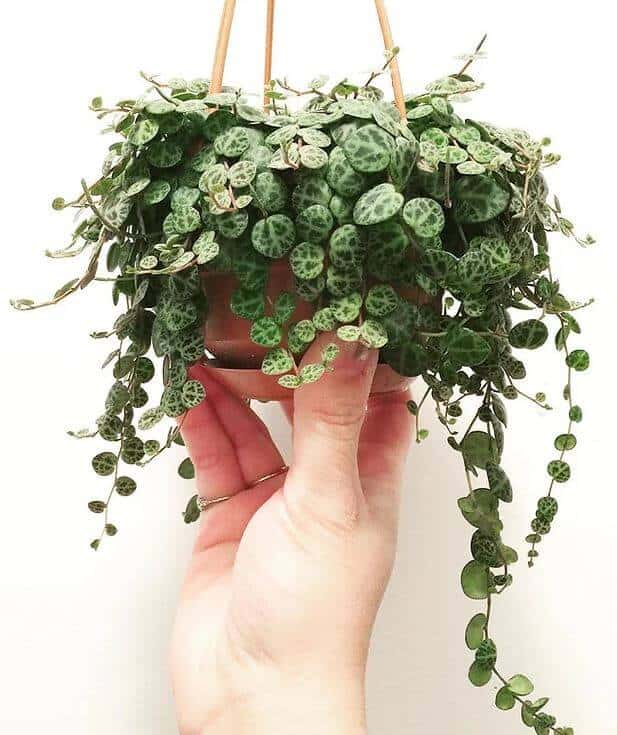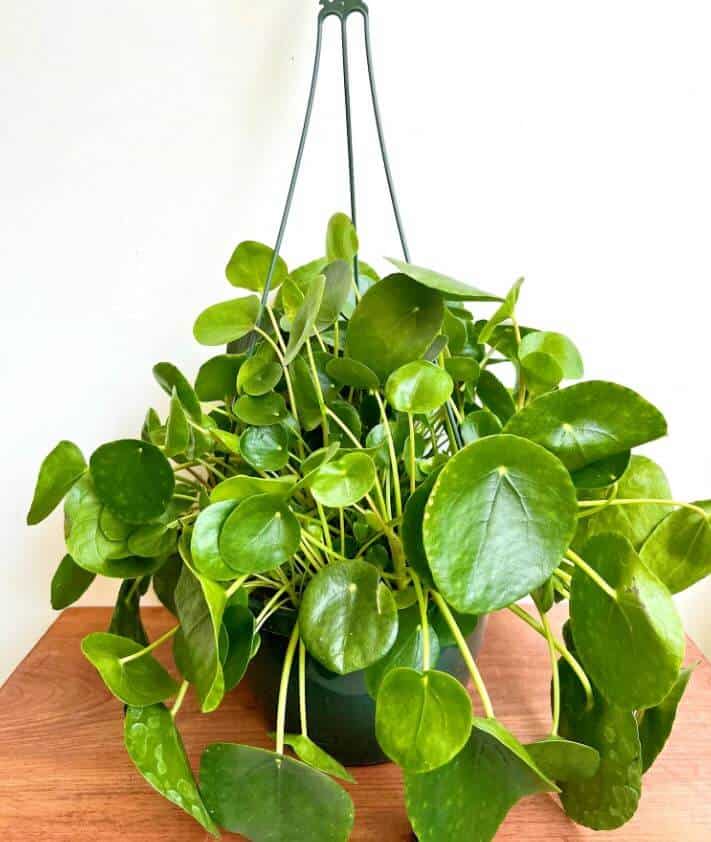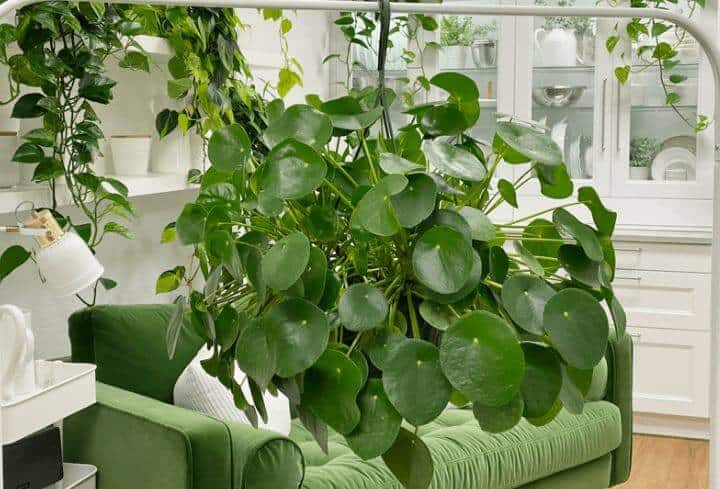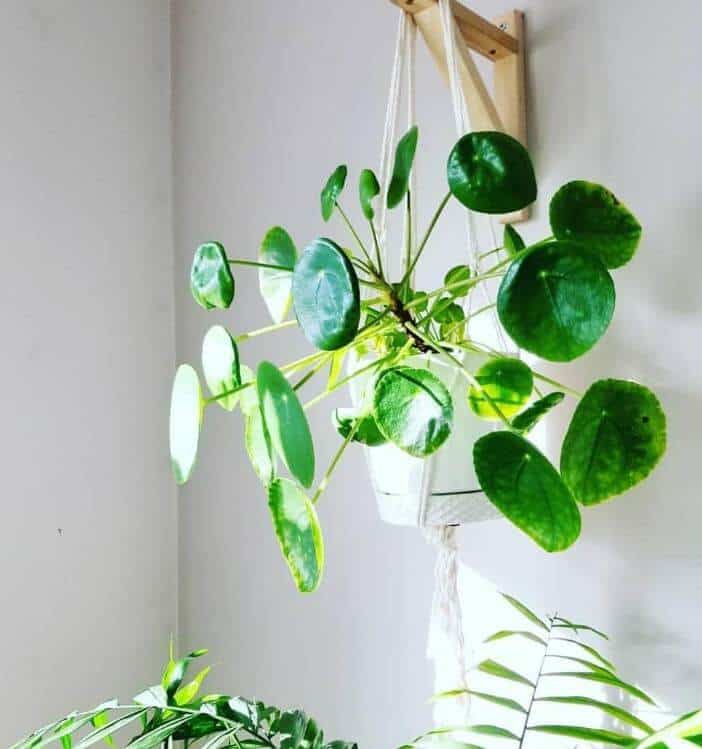Last Updated on September 9, 2023 by a Friendly Gardener
The Pilea Peperomioides, commonly known as the Chinese Money plant, the Pancake plant, the coin plant, or the UFO plant, is a lovely, easy-to-maintain house plant that finds its native habitat in Southern China. Appreciated for its eye-catching coin-shaped foliage with a light green spot at its center, the leaves resemble flat pancakes attached to arching stems.
These evergreen perennials are a stunning addition when cultivated in a hanging basket, on a bookcase shelf, or from a position that allows the cascading leaves to tumble downward. They can grow to a height of a foot and from 8 to 12 inches in width. Minimal, yet lush, they are perfect for any indoor décor and any location.
While the hanging Pilea is easy to grow, it also is quick to die if not in a proper environment with the correct care. A member of the Urticaceae family, it is a rapid grower but can maintain a compact structure. If a Pilea blooms it will be in the spring producing white blossoms, although it is rare for an indoor plant to flower.
Hanging Pilea Plant Care

Caring for a hanging Pilea is not difficult if you guarantee basic environmental conditions. Remember that the hanging Pilea is a tropical rainforest plant that thrives in dappled light and humid conditions.
Soil
Select a hanging pot that ensures good drainage. Should your soil bed remain too moist for too long a period, the plant will be susceptible to root rot which can be fatal. A terra-cotta or clay pot in a macrame or cord hanger is ideal. These pots breathe and aid in wicking away excess moisture consequently drying the soil more rapidly. Another option is to place a terra cotta pot inside another more attractive hanging pot.
Quality potting soil is fine for the hanging Pilea plant, however, if you tend to overwater, consider using a cactus-growing medium or a succulent mix. This type of soil mixture will dry out faster and ensure that the root system breathes. The Pilea likes soil that has a slightly acidic to neutral pH (6 to 7).
Light

As a member of the tropical rainforest, the hanging Pilea should not be exposed to direct sunlight, or the foliage will scorch. They do need dappled bright indirect light. Insufficient light will lead them to become leggy and leaves may be smaller and turn yellow.
Money plants tend to reach for the light, so rotate your plant regularly for balanced growth.
Water
It’s fundamental to the hanging Pilea’s overall health that it is not overwatered. Overwatering is the fastest way to kill this plant. Always insert your finger 2 to 3 inches into the plant’s soil bed. Should the soil feel a bit damp, wait before watering. If the soil bed feels dry, give your hanging Pilea a thorough soaking. Better than this plant wilts a bit as opposed to risking overwatering. If your Pilea wilts a bit, it will revive immediately after watering.
Reduce your watering schedule in winter checking the soil always before watering. Don’t be alarmed if several weeks pass. If you prefer not to dip your finger into the soil bed, get a moisture meter from your garden center.
Humidity
As members of tropical rain forests, your Pilea will like a bit of humidity. Average house humidity should suffice. If brown edges appear on leaves, the air is too dry. Try misting daily or use a space humidifier or pebble tray to improve environmental conditions.
Temperature
Hanging Pilea plants do well in the average home temperature. Keep them away from air conditioning or heating units and vents as they will suffer in dry air conditions. The Pilea raised outside is freezing hardy. Indoor plants should not be exposed to temperatures that drop lower than 50°F. Short exposure to a bit of cold will promote blooming in spring.
Feeding
While not a heavy feeder, the hanging Pilea can do with some fertilization. During the spring, summer, and fall seasons, fertilize your plant with every other watering. A balanced liquid houseplant fertilizer diluted to half strength should suffice. Interrupt fertilization in winter when the plant enters dormancy.
Pruning
If your plant gets leggy, it’s time to prune it. If you prefer a fuller, bushier look, do not remove the new plantlets growing at the base of your hanging Pilea plant. By permitting the growth density, you can train it to grow over the sides of your hanging planter.
Repotting

The hanging Pilea plant grows relatively rapidly. Plan on changing the soil, and perhaps the container size annually. Repot your Pilea during the spring season.
Hanging Pilea Propagation

The easiest and quickest method for Pilea propagation is using offsets. Your Pilea will produce little plantlets or baby Pileas at its base. When they appear, it’s a good time to propagate your plant. Using a sterile sharp gardening knife, go underneath the soil surface and sever the baby plants from the parent plant. Position the baby Pilea plant in a small jar or container of water. The leaves should not be placed in the water. Change the water every several days and wait for the new roots to appear. Once there is substantial root growth, transplant the baby into potting soil and water thoroughly.
Hanging Pileas can also be cultivated from cuttings. Cut a stem from the top of the plant below a leaf node. Remove all of the bottom leaves from the cutting. Now root the cutting in a jar of water. When pruning, plant cuttings can be used in this manner.
Pilea Hanging Plant Problems
Problems for the Pilea can be due to disease, improper care, or pests.
Pests
When dealing with pest infestations, there are several bugs that may find your hanging Pilea plant attractive.
-
Gnats
These pesky little flies are really no threat to you or to your plant, but they can be bothersome. To rid the plant of gnats, water it using a solution of tap water and hydrogen peroxide with a 1 to 4 ratio. You can also spray the soil surface with organic Neem oil. Repeat spraying the soil surface every few days until the gnats have disappeared.
-
Mealybugs
Cottony-looking deposits can be removed manually before treatment.
-
Scale
Waxy deposits are found on leaves and stems. They can be scraped off before treatment.
-
Spider mites
Spider mites look like small spots. They generally like dry conditions. If you see leaves covered in moving spots or webbing on the underside of leaves, treat your plant with insecticidal soap or Neem oil.
Other problems might include:
- Brown edges due to dry air. Try misting daily.
- Curling leaves may indicate insufficient light, high environmental temps or too little humidity.
- Brown leaves indicate too much sun.
- Yellow leaves that drop indicates overwatering.
Hanging Pilea Plant Toxicity

The hanging Pilea plant, while not necessarily easy to reach unless your feline is particularly adept in gymnastics, is not toxic. So should a cat, dog, or even small child take a taste, don’t worry!

